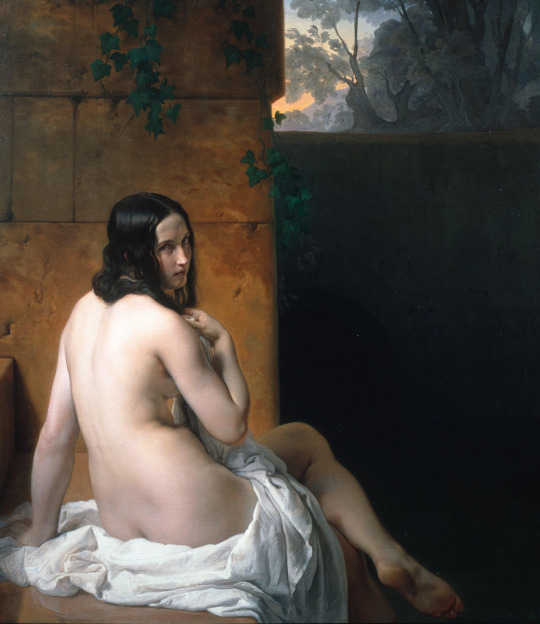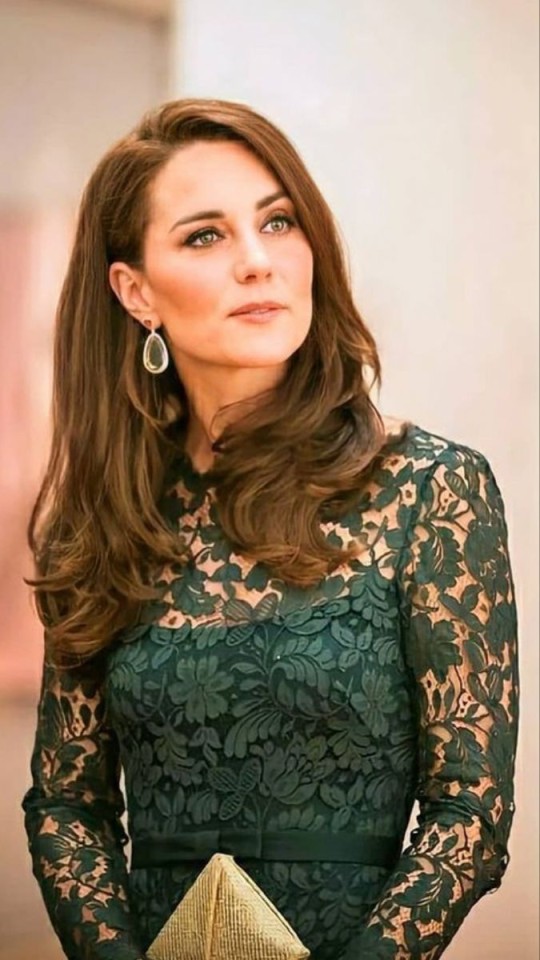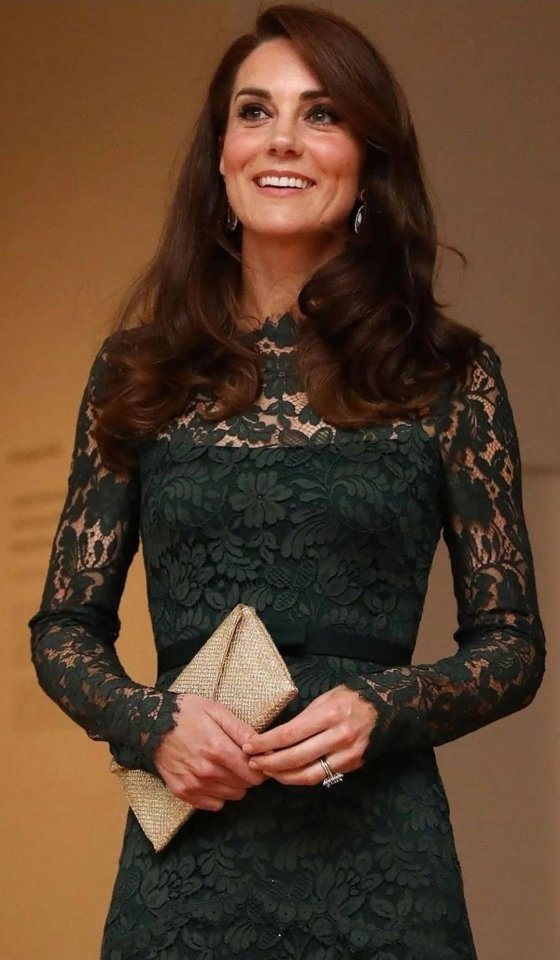#london national gallery
Explore tagged Tumblr posts
Text

Susanna at her Bath | Francesco Hayez | 1850 | London National Gallery
"Hayez was the leading artist of mid-19th-century Milan, renowned for his elegant draughtsmanship and polished execution. The Old Testament story of Susanna bathing provided him with a pretext for painting one of his favourite subjects, the female nude"
A description from an exhibition at Wallraf-Richartz-Museum in Cologne (December 2022):
"Alone with Susanna
A Susanna almost without the Elders. The painter only vaguely indicates the two old men in the background between the trees - obscured by light from behind and the haze of dawn. Looking over her shoulder Susanna identifies the real intruder in the intimate bathing scene: the viewer! The voyeuristic perspective puts him in the position of the Elders - pleasurably enjoying the scene or embarrassed? Casually supporting herself on one arm, with her crossed leg elegantly pointing in our direction, Susanna appears self-confident rather than alarmed. The same applies to her slight upward gaze that fascinates us - almost hypnotically. Is she giving us the "cold shoulder" as a calculated form of provocation? "
#Susanna at her Bath#francesco hayez#London#london national gallery#susanna#old testament#milan#academism#romantism
32 notes
·
View notes
Text
Photos do not do justice how vibrant Ultramarine blue appears in real life

I recently went to see the national gallery in London, an entire section of which is dedicated to depictions of Mary. In this room full of the same woman in her same red dress and blue cloak, some pieces floor to ceiling. Your eye is instead draw immediately to this small , 73 by 58 cm (29 by 23 inch), The Virgin in Prayer by Giovani Battista because it uses a blue simply so brilliant you cannot look away from it.
so many blues in that room, blues which in pictures online appear almost the same, so different in real life.
#poetry#literature#art#philosophy#existentialism#love#commentary#aesthetic#bible#poems on tumblr#virgin mary#London national gallery
3 notes
·
View notes
Text

Apollo e Dafne-Piero del Pollaiolo (1470)
1 note
·
View note
Text









some of van gogh’s paintings at the poets and lovers exhibition in the national gallery
+ my all time favourite work of his:

1K notes
·
View notes
Text

Judith, (detail), (ca.1678) by Eglon Hendrik van der Neer (1634–1703), oil on oak, 32 × 24.6 cm, The National Gallery, London
#judith#judith and holofernes#eglon hendrik van de neer#painting#detail#historiated painting#art#fine art#national gallery#london#oil on oak#woman with sword#portrait#my upload
2K notes
·
View notes
Text

The Umbrellas, Pierre-Auguste Renoir, between 1881 and 1886
#art#art history#Renoir#Pierre-Auguste Renoir#genre painting#genre art#Impressionism#Impressionist art#French Impressionism#French art#19th century art#oil on canvas#National Gallery#National Gallery London
549 notes
·
View notes
Text




19th of October 2024. Van Gogh: Poets & Lovers exhibition at the National Gallery, London.
#vincent van gogh#national gallery london#art#museum#art musuem#paintings#light academia#dark academia#light aesthetic#studyblr#study blog#my photos#london#art aesthetic#aesthetic#art work#museum aesthetic#artist#classic aesthetic#travelblr#art history
121 notes
·
View notes
Text

The Water-Lily Pond (1899) 🎨 Claude Monet 🏛️ The National Gallery 📍 London, United Kingdom
For Monet, gardens offered a refuge from the modern urban and industrial world, although he and his fellow garden enthusiasts benefited from modern advances in botanical science that were creating new hybrid flowers in a wide choice of shapes and colours that could be produced on an almost industrial scale. He made modest gardens in the homes he rented in Argenteuil and Vetheuil in the 1870s, but from 1883, when he moved to a rented house in Giverny, about 50 miles to the west of Paris, he had more scope to indulge his passion for plants. He became a dedicated gardener with an extensive botanical knowledge, and sought the opinions of leading horticulturalists. As Monet’s career flourished his increasing wealth enabled him to fund what became a grand horticultural enterprise: by the 1890s he was employing as many as eight gardeners.
Monet began by refashioning the garden in front of the house, the so-called ‘Clos Normand’, replacing the existing kitchen garden and orchard with densely planted colourful flower beds that were filled with blooms throughout the seasons. He was able to buy the house in 1890, and three years later he purchased an adjacent plot of land next to the river Epte beyond the railway line at the edge of his property. The plot had a small pond with arrowhead and wild water lilies, which he wanted to turn into a water garden with a larger lily pond ‘both for the pleasure of the eye and for the purpose of having subjects to paint’.
The idea may have occurred to him after he had seen the water garden at the 1899 Exposition Universelle in Paris created by the grower Joseph Bory Latour-Marliac, who bred the first colourful hardy waterlilies. Monet began by requesting permission from the Prefect of the Eure to dig irrigation channels from the Ru – a branch of the Epte – to feed his pond, but the Giverny villagers objected, fearing it would contaminate the water and that the foreign plants would poison their cattle. Monet was furious, but three months later permission came through and he began to enlarge the existing pond, replacing the wild water lilies with Latour-Marliac hybrids available in yellows, pinks, whites and violets.
The pond was enlarged on further occasions – in 1901 and 1904 – tripling the size of the water garden. Together with the flower garden on the other side of the railway track it became the principal preoccupation of the last 26 years of Monet’s life. While the Clos Normand garden was laid out along fairly traditional lines, harking back to the formal French gardens of seventeenth-century Europe, with a central alleyway and geometrically arranged beds, the water garden was more Eastern in inspiration. Its less regimented, more natural design and more muted colours created a quieter, meditative atmosphere. Monet erected a Japanese bridge over the western end of the pond that took its inspiration from the bridges in ukiyo-e Japanese prints. He was a keen collector of these prints and he owned a copy of Hiroshige’s Wisteria at Kameido Tenjin Shrine (1856), one of the many prints that features a curved bridge. In a more general sense, the water garden reflected Monet’s admiration for the Japanese appreciation of nature.
Monet had to wait for his water garden to mature before he could begin to paint it in earnest. As he later recalled: ‘It took me some time to understand my water-lilies. It takes more than a day to get under your skin. And then all at once, I had the revelation – how wonderful my pond was – and reached for my palette. I’ve hardly had any other subject since that moment.’ In total, Monet painted 250 canvases of his water garden. Around 200 of these represent water lilies floating on the surface of the water, while the remainder also show the Japanese bridge, the weeping willow trees and wisteria and the irises, agapanthus and day lilies on its banks. In all these pictures Monet was painting a subject that was already ‘pictorial’ – a landscape that had been carefully composed according to his personal aesthetic. The National Gallery has three further paintings of the water garden :Water-lilies, setting sun; Irises; and Water-lilies.
Monet painted three views of the Japanese bridge in 1895, not long after it had been constructed, but then took a break from the subject, only returning to it in 1899. By now the pool was overhung by vegetation and surrounded by plants, but to judge from contemporary photographs it was never as enclosed as Monet painted it, and he exaggerated the feeling of claustrophobia. In December 1900 he exhibited 12 paintings at Durand-Ruel’s gallery in Paris, all of which showed more or less symmetrical views of the Japanese bridge.
In this painting, as in the others in the series, we are looking down onto the surface of the water, where the lily pads float into the distance, meeting the dense foliage on the far bank. Weeping willows are reflected in the pond and clumps of iris border its banks. The perspective seems to shift so that it is hard to find a single focal point; it is as though we are looking up at the bridge but down on the waterlilies. The picture, like the water itself, seems to oscillate between surface and depth. The mainly vertical reflections provide a counterpoint to the horizontal clumps of the lily pads. Different colours, applied with thick brushstrokes, are placed next to each other. This way of painting has more in common with Monet’s early Impressionist works than his more recent paintings of mornings on the Seine, where he had used softer, more blended strokes to convey hazy atmospheric effects.
The Japanese bridge series marked a turning point in Monet’s art. From now on his subjects were painted from an increasingly confined viewpoint, conveying the sense of an enclosed world. In later paintings of the pond, he would dispense with the banks and bridge altogether to focus solely on the water, the reflections and the water lilies. The culmination of Monet’s water lily paintings were the Grandes Dėcorations, 22 enormous canvases each over two metres high and totalling more than 90 metres in length, which he completed months before his death and donated to the French state. These are now on permanent display in two oval rooms in the Musée de l’Orangerie, Paris.
#The Water-Lily Pond#1899#Claude Monet#The National Gallery#London#United Kingdom#oil painting#painting#oil on canvas#Modern art#Impressionism#french#art#artwork#art history
134 notes
·
View notes
Text

A nymph by a stream, 1869–70, National Gallery, London - by Pierre-Auguste Renoir (1841 - 1919), French
65 notes
·
View notes
Text
Kate Moss and Alexander McQueen at the National Portrait Gallery London, January 2002
Ph. Mario Testino

#kate moss#kate mess#cocaine kate#lee alexander mcqueen#alexander mcqueen#national portrait gallery#london girl#london#mario testino#fashion history#high fashion#history of fashion#fashion design#fashion desingers#supermodel#fashion photography#vintage fashion#vintage style#2000s supermodels#2000s fashion#90s supermodel#1990s#photography#1990s fashion
31 notes
·
View notes
Text

A museum is a place where one should lose one's head.
-- Renzo Piano
(London)
#museum#national gallery#lost#renzo piano#travel photography#london#uk#england#quote#art#gallery#lose yourself
139 notes
·
View notes
Text






Catherine, Duchess of Cambridge attends the Portrait Gala 2017 at the National Portrait Gallery on March 28, 2017 in London, England.
#kate middleton#catherine duchess of cambridge#national portrait gallery#2017#temperley london#green lace#royal fashion#british royal family#royal style#british royal fandom#royal family#british royalty
92 notes
·
View notes
Text



Van Goghs that I have 1) seen in person, and 2) cried in public about.
#hi we are in london and we did the national gallery van gogh exhibit this morning and I cried#like. five times. just stiod there in fron of paintings and cried.#i have so many feelings#van gogh#personal
39 notes
·
View notes
Text

Sandro Botticelli (1445-1510)
Portrait of a Young Man, 1480-5
Tempera and oil on wood, 37.5 × 28.3 cm
#sandro botticelli#botticelli#fine art#art#artwork#paintings#artists on tumblr#painting#artist#national gallery london#renaissance#renaissance art#italian renaissance#tempera painting#oil on panel#portrait painting#portraits#portrait#art history#art on tumblr#art of the day#florence#antique painting#old master painting#Firenze#italian painter#italian artist#italian art
39 notes
·
View notes
Text

Giovanni Battista Tiepolo | An Allegory with Venus and Time | NG6387
#mine#Giovanni Battista Tiepolo#art#art gallery#fine art#art history#artwork#painting#18th century#18th century art#london#national gallery london
30 notes
·
View notes
Text

The Execution of Lady Jane Grey (1833), (detail), by Paul Delaroche (French, 1797-1856), oil on canvas, 246 cm × 297 cm, The National Gallery, London
#the execution of lady jane grey#paul delaroche#my upload#19th century#painting#painting detail#detail#oil on canvas#national gallery london#national gallery#london#lady jane grey#nine days’ queen#tableau vivant#historical painting#art#fine art
163 notes
·
View notes